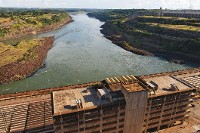Planning for a Country's Energy Needs
Ensuring that a country has an adequate supply of energy isn’t easy. Not only do energy planners need to balance energy needs against energy resources, they must also plan over the long term (most power plants are in use for 25 years or more) in such a way that long-lived damage to the environment is not caused. Yet without sufficient energy, a country will struggle to produce goods and provide basic services such as health care or sanitation for its people.
Helping countries through the complexities of energy planning is the International Atomic Energy Agency (IAEA)—the only UN agency tasked with building capacity in overall energy planning. Among the tools the IAEA has chosen to assist countries in identifying the most cost-effective energy system is an IIASA-developed systems analysis tool, known as MESSAGE (Model for Energy Supply System Alternatives and their General Environmental impacts). MESSAGE has helped energy planning bodies in more than 80 countries to formulate and evaluate alternative energy supply options for a nation or region, taking into account local constraints.
Brazil’s energy planners use IIASA’s MESSAGE model to produce long-term energy scenarios for the country. Part of Brazil’s energy system is the Itaipu hydroelectric power plant (see photo), which generates enormous amounts of electricity for both Brazil and Paraguay.
“MESSAGE has had a big impact on the way energy planning is done in Brazil,” explains Prof. Roberto Schaeffer of the Federal University of Rio de Janeiro. In 2002 the IAEA had introduced MESSAGE to a team of Brazilian partners, including Schaeffer, to explore paths to sustainable energy development. The resulting assessment was so successful that the Energy Research Company of Brazil’s Ministry of Mines and Energy, the company in charge of producing long-term scenarios for Brazil, has continued to use MESSAGE as one of its official modeling tools ever since.
“MESSAGE is a powerful tool for helping countries plan their energy systems because the model aims to find an optimum solution for the energy system as a whole, and not optimum solutions for only specific parts of the system,” says Schaeffer. Analysis using MESSAGE begins with an assessment of existing energy infrastructure. Then, based on a range of future expansion scenarios, the tool helps design long-term strategies by analyzing cost-optimal energy mixes, investment needs, and other costs, as well as technical, financial, or policy constraints such as energy supply security or the rate at which new technologies can be introduced.
More recently, the IAEA has been using MESSAGE in a range of ongoing projects in Burkina Faso, Ivory Coast, Mauritania and Niger to determine the levels of power station investment and the kinds of power plant required to meet the growing demand for electricity.
“In Niger,” Hans-Holger Rogner, Head of the IAEA’s Planning and Economic Studies Section, points out: “The analysis has been hugely informative.” Energy planners found large coal reserves in one isolated part of the country where the demand for electricity did not merit the building of a coal power plant. Instead the remote region generated electricity for itself using expensive diesel generators. If electricity demand were to develop, however, then a coal power plant could be sustained.
“MESSAGE showed that interconnecting the remote region to the main grid would give it access to electricity at a lower cost than using its current generators,” Rogner explains. The cost of the interconnection could be recouped when demand for electricity (elsewhere in the country and for export) was high enough to merit the coal plant being built. The coal plant could then supply some of the remote region’s electricity, with the balance being shipped out of the region, using the transmission system which initially brought electricity in.
“In such ways,” Rogner concludes, “the IAEA aims to build the capacities of institutions in developing countries so that they can independently chart their energy demand and supply strategies and test the effectiveness of different energy and environmental policy options. MESSAGE is one of the most commonly used analytical tools for this purpose.”
MODELS AND DATA
RESEARCH PARTNERS


